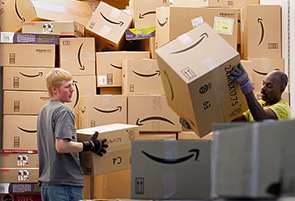A Green Dilemma for the Holidays:
Better to Shop Online or In-Store?
By Crystal Gammon
The conventional wisdom has been that shopping online is environmentally preferable to going to a brick-and-mortar store. But a new study suggests it’s not quite as simple as that.
Gazette Introductory Note: The green dilemma presented here is a lot like the environmental nitpicking that goes on with such issues as paper vs. plastic at the supermarket, real vs. artificial for Christmas trees, or burial vs. cremation when the whole thing winds down. The real answer is usually hardly mentioned or at best played down: the best tree is no tree, the best bag is no bag, and the worst choice of all at the very end is to put off dying. Holiday purchasing is, of course, so complex an issue that a mere consideration of how the package gets to your home is only one of dozens of factors that would have to be considered to come to a rational decision. My own answer is that whether you drive to the mall to pick up the baseball cap for your cousin or have it delivered in a UPS truck is largely unimportant; what is important is whether you should buy the cap in the first place. There are lots of alternatives to buying things. We need to be brave enough to explore them rather than simply caving in every time the merchants, brick-and-mortar or online, start ringing the bells of Christmas. Bah, Humbug!– Hardly Waite.
As holiday packages arrive at doorsteps and gifts pile up under Christmas trees, environmentally-minded consumers may wonder, what’s the most carbon-conscious way to shop — online or in-store?
Various studies in recent years have suggested that online shopping typically packs a lower carbon punch than shopping at brick-and-mortar stores. But new research published online in the Journal of Cleaner Production suggests the story is more complicated than that.
“Consumer travel and behavior is critical,” said Patricia van Loon, a logistics researcher at the international business school INSEAD and lead author of the study. The key, she said, is to minimize the number of miles driven per item — whether by the shopper, a local delivery van, or a FedEx truck.
A typical online order, with goods delivered by truck, has a carbon footprint roughly three times as large as a brick-and-mortar shopping trip, according to van Loon’s analysis, which looked at U.K. shoppers buying household goods. That’s because brick-and-mortar shoppers typically buy many more items at once than online customers, she said. Moreover, online shoppers will often make extra trips to the store anyway — to pick up items they forgot to order, return unwanted ones, or to browse and test products — a factor previous studies largely ignored.
On an item-by-item basis, however, online shopping usually does win out, van Loon’s analysis shows. Purchasing a single item online and having it delivered by truck has roughly half the carbon footprint as driving to a local store to buy it, she found. Yet her calculation is based on driving — the results would be different in a bicycle-centric country like the Netherlands, the study points out, or in a place like Manhattan, where pedestrians and public transportation dominate.
Clearly, online shopping continues to boom. Amazon, the United States’ largest online retailer, did nearly $75 billion in web-based sales last year, including the 37 million items — 426 per second — it sold on Cyber Monday. This year, total online sales on that day in the U.S. grew by 17 percent, to over $2 billion, making it the heaviest online shopping day ever.
To maximize efficiency, van Loon said, consumers generally should buy online and should plan orders so that each contains as many items as possible. “In that case, online shopping … can be even better than walking to the store,” she said, because warehouses tend to be more energy-efficient than local stores.
But numbers-crunching aside, what should a carbon-conscious shopper do?
“Give yourself more time to plan,” recommends Darby Hoover, a senior resource specialist with the Natural Resources Defense Council. She said planning ahead can allow consumers to choose more flexible shipping options — “Do you really need it to get there tomorrow?” — and to buy from companies with environmentally friendly policies, such as minimizing packaging.
And if waiting longer for a product is not an option, Hoover said, “focus on efficiency and using less stuff, and bring that approach to whatever decision you’re trying to make.”
Source: Environment 360 (Yale University).
Pure Water Gazette Fair Use Statement
There’s a lot more to determining the carbon footprint of Rex’s new cap than whether you bought it from Amazon or at the pet store in the shopping center.–Hardly Waite.





